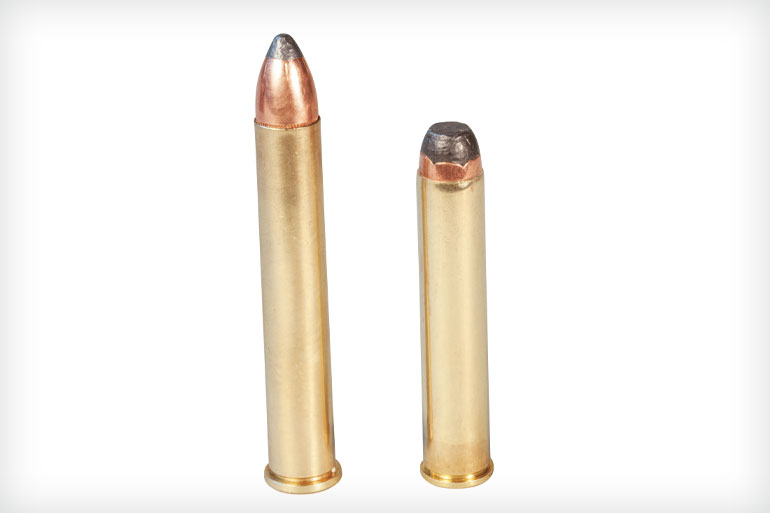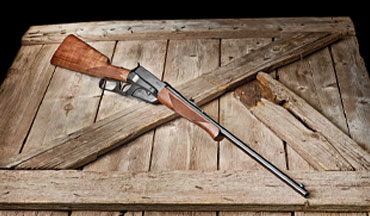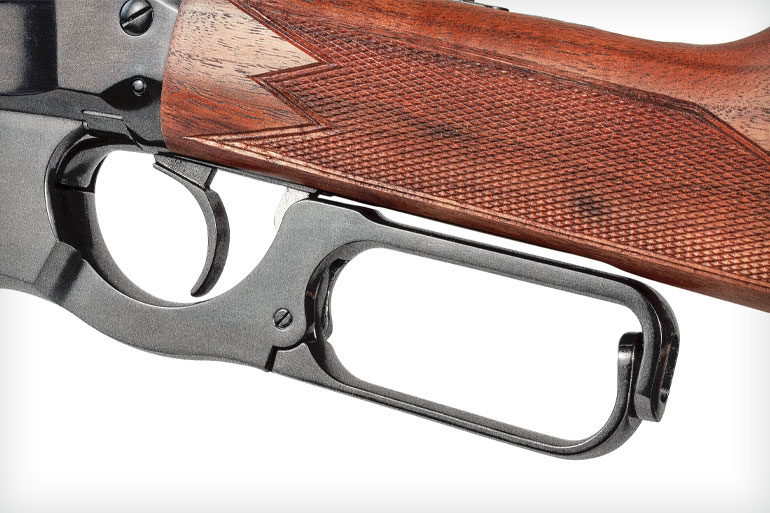Winchester’s famous Model 1895 celebrates its 125th anniversary with the .405 Win. chambering.
On the left side of the receiver, you’ll find one large threaded hole and two smaller ones fitted with screws. These permit installation of a receiver sight. At one time Lyman made a sight specifically for the 1895; today you can get a reproduction of the sight from Buffalo Arms. Just be mindful that when shopping for sights you’ll see references to 1895 that refer to Marlin and not Winchester.
Williams still makes a receiver sight for the Winchester 1895, but the company notes its FP-Winchester 71 will not fit on .405 Win. versions of the rifle.
I love the wood on this gun. It’s oil-finished black walnut, nothing fancy but with a handsome grain. The checkering is done in a bordered point pattern, and it’s very nicely executed. The well-shaped fore-end feels good in the hands and features a graceful Schnabel tip. Wood-to-metal fit is proud all the way around, but at least it’s consistent. As befits a lever action of its era, there are no sling swivel studs.

The buttstock has a plain, black metal buttplate. It’s traditional, if not particularly comfortable to shoot.
While the current rifle is also available in .30-06, I think for most people the .405 Win., which made its debut in 1904, will be the more interesting chambering. It’s a straight wall with a case length of 2.583 inches, longer than both the .444 Marlin (2.225 inches) and .45-70 Gov’t (2.105 inches).
Hornady’s current load throws a 300-grain pointed softpoint bullet at 2,200 fps out of this rifle, and for once the chronograph figures I got exactly matched the book specs. That translates to 3,225 ft.-lbs. of energy at the muzzle.
To put this in context, it’s considerably more energy than most 300-grain .45-70 loads (around 2,200 ft.-lbs.), although, of course, factory loads for the Government are purposely held low because of all the old rifles out there. The .405 also outdoes Hornady’s 265-grain LeverEvolution load in the .444 Marlin at 3,180 ft.-lbs., but the .444 Marlin Superformance (3,389 ft.-lbs.) and LeverEvolution .450 Marlin (3,572 ft.-lbs.) are more powerful.
Roosevelt felt the .405 was a fine lion cartridge, but he and his son Kermit also used it to take rhinos and even elephants. Results on the latter were decidedly mixed, and Roosevelt admitted it was a bit wanting at the largest end of the game spectrum.

“Our experience had convinced us that both the Winchester .405 and the Springfield .300 [.30-06] would do good work with elephants; although I kept to my belief that, for such very heavy game, my Holland .500/450 was an even better weapon,” he wrote in African Game Trails.
As an aside, I was discussing this cartridge with Craig Boddington, and he told me his daughter Brittany used the .405 Win. on Cape buffalo. However, she was shooting the cartridge in the stronger Ruger No. 1 action, which allows the round to be loaded much hotter and with heavier bullets than would be safe even in a modern-built 1895.
So if this cartridge has acquitted itself well in the hunting fields, why is it so obscure? Part of the reason is its oddball .411 bullet diameter. It’s close to the .410 diameter of the .450/400 Nitro Express 3-inch, which is justifiably admired as a dangerous-game cartridge, but the Nitro pushes a 400-grain bullet at 2,050 fps for 3,700 ft.-lbs. of energy.
From there, you’ve got the various powerful .416s, which use .416-inch bullets as their designation suggests. And then there’s the .404 Jeffery, a superb dangerous-game round. Ironically, while .405 is a bigger number than .404, the Jeffery takes a .423-inch bullet.
Bullet size notwithstanding, even in the .405’s heyday the majority of big game hunting in the United States involved deer-size game, and while today you would include hogs as well, then as now there isn’t a ton of call for a cartridge on the .405’s power level.

But speaking of wild boar, Boddington said with the standard 300-grain load it’s “lights out” on hogs, and it certainly has enough energy to tackle the biggest North American game. And today we’re seeing a resurgence in straight-wall cartridges due to some formerly shotgun-only states now allowing straight-wall centerfires for deer hunting. Could the .405 fit in here?
If you zero at 100 yards, the .405 is dropping 8.3 inches at 200 yards and 30.2 inches at 300 yards—with 1,727 ft.-lbs. and 1,250 ft.-lbs. of energy respectively. While that’s a lot of energy, it doesn’t stack up as well in terms of trajectory. Cartridges like the .350 Legend, .450 Marlin, .444 Marlin and .450 Bushmaster are dropping in the 4.5- to 5.7-inch range at 200 yards, with the .45-70 close to seven inches.

But trajectory is just a number. If you range-confirm your drop and do the math, you can still hit your target—and with the .405 you can be sure you’ll be delivering sufficient power.
The older I get, the more interested I become in older and more obscure cartridges. The .405 Win. certainly qualifies, and I think the 1895 would be a fantastic wild boar, elk, bear or moose hunting companion, and it would be a unique deer rifle as well.
I grant you it’s not a ton of fun from the bench. The straight stock with its 27/8-inch drop and hard metal buttplate accentuate recoil forces, but it’s way more pleasurable to shoot than a big, high-pressure magnum.
I did manage to generate some good groups from the bench with the iron sights, albeit at 50 yards. One hundred yards ain’t happening with my eyes and sights like these, at least not for a realistic assessment of the rifle’s accuracy potential. However, I found that by placing the gold bead of the front sight so it sat just atop the fine portion of the notch, I could get an okay sight picture.
While the .405 is distinctly lacking in factory offerings, fortunately for the 1895 it loves Hornady’s 300-grain load. The average wasn’t bad, and I was able to shoot one group under an inch, all shots touching—indicating that with younger eyes and/or an aperture sight you could get plenty of accuracy. I did shoot a couple 100-yard groups just for fun, and they came in around 2.5 inches—generally in line with what I got at 50 yards.
I worked up four handloads with Hodgdon H4198 and the same Hornady bullets found in its factory ammo. I began with the starting load listed in the Hodgdon manual and ended one grain short of max. The rifle didn’t like the starting load at all, and it’s not included in the accompanying accuracy chart. It’s interesting to see how the accuracy improved as velocity went up, so this gun seems to like ’em on the warm side.
Shooting from field positions was fun. The lever works smoothly, and the rifle comes back on target reasonably quickly thanks to its eight-pound weight—which isn’t a bad field-carrying load at all. At 50 yards offhand I could keep all of my shots in a volleyball with a relatively rapid rate of fire. I also shot the rifle from unsupported sitting at 100 yards and would have all the confidence in the world I could hit a six-inch vital zone every time.
Cartridges load easily into the straight-stack internal magazine, snapping home with a satisfying “snick.” Feeding was flawless.
I always find it enjoyable to work with a rifle that has a storied history, and the Winchester 1895 certainly has one. Winchester sees it much the same way.
“The fact that we’re still producing the M95 is a huge testimony to the Winchester brand and the position it has in the marketplace,” Nielsen said. “Few companies get to claim they are still building the same guns that brought them to the table. If we can still build and sell a gun designed over 100 years ago, then we’re doing something right.”
You’ll get no argument from me on that score. I love the latest, greatest cartridges and gun designs we have available to us today—we’re living in a golden age, for sure—but there’s a lot to be said for a 125-year-old design and 116-year-old cartridge that are still ready, willing and able to continue to serve America’s hunters.
Winchester Model 1895 Specs
- Type: Lever-action centerfire
- Caliber: .30-06, .405 Win. (tested)
- Capacity: 4-round internal magazine
- Barrel: 24 in., 1:10 twist (as tested)
- Weight: 8 lb.
- Overall Length: 42 in.
- Finish: Brushed polished
- Stock: Black walnut
- Sights: Open; gold bead front
- Safety: 2-position sliding tang
- Price: $1,180
- Manufacturer: Winchester, WinchesterGuns.com
Winchester Model 1895 Accuracy Results


